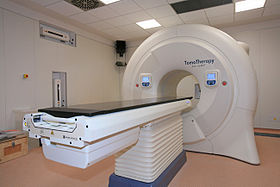Tomotherapy
This article may require cleanup to meet Wikipedia's quality standards. The specific problem is: This is mostly jargon. (August 2023) |
| Tomotherapy | |
|---|---|
 Tomotherapy Hi Art machine | |
| Other names | Helical tomotherapy |
| Specialty | oncology |
Tomotherapy is a type of
General principles
The treatment field's length (the width of the radiation slice) is adjustable using collimator jaws. In static-jaw delivery, the field length remains constant during a treatment. In dynamic-jaw delivery, the field length changes so that it begins and ends at its minimum setting.

Tomotherapy treatment times vary compared to normal radiation therapy treatment times. Tomotherapy treatment times can be as low as 6.5 minutes for common prostate treatment,[7] excluding extra time for imaging. Modern tomotherapy and conventional linac systems incorporate one or both of megavoltage X-ray or kilovoltage X-ray imaging systems, enabling image-guided radiation therapy (IMRT). In tomotherapy, images are acquired in a very similar manner to a CT scanner, thanks to their closely related design.[8][9][10]
There are few head-to-head comparisons of tomotherapy and other IMRT techniques, however there is some evidence that a conventional linac using VMAT can provide faster treatment whereas tomotherapy is better able to spare surrounding healthy tissue while delivering a uniform dose.[11][12][13]
Helical delivery
In helical tomotherapy, the linac rotates on its gantry at a constant speed while the beam is delivered; so that from the patient's perspective, the shape traced out by the linac is helical.[14]
While helical tomotherapy can treat very long volumes without a need to abut fields in the longitudinal direction, it does display a distinct artifact due to "thread effect"[15] when treating non-central tumors. Thread effect can be suppressed during planning through good pitch selection.
Fixed-angle delivery
Fixed-angle tomotherapy uses multiple tomotherapy beams, each delivered from a separate fixed gantry angle, in which only the couch moves during beam delivery. This is branded as TomoDirect, but has also been called topotherapy.[16]
The technology enables fixed beam treatments by moving the patient through the machine bore while maintaining specified beam angles.
Clinical considerations
In general, radiation therapy (or radiotherapy) has developed with a strong reliance on homogeneity of dose throughout the tumor. Tomotherapy embodies the sequential delivery of radiation to different parts of the tumor which raises two important issues. First, this method is known as "field matching" and brings with it the possibility of a less-than-perfect match between two adjacent fields with a resultant hot and/or cold spot within the tumor. The second issue is that if the patient or tumor moves during this sequential delivery, then again, a hot or cold spot will result. The first problem is reduced by use of a helical motion, as in
Some research has suggested tomotherapy provides more conformal treatment plans and decreased acute toxicity.[21]
Non-helical static beam techniques such as IMRT and TomoDirect are well suited to whole breast radiation therapy. These treatment modes avoid the low-dose integral
This risk is accentuated in younger patients with early-stage breast cancer, where cure rates are high and life expectancy is substantial.[24]
Static beam angle approaches aim to maximize the
History
The tomotherapy technique was developed in the early 1990s at the University of Wisconsin–Madison by Professor Thomas Rockwell Mackie and Paul Reckwerdt.[28] A small megavoltage x-ray source was mounted in a similar fashion to a CT x-ray source, and the geometry provided the opportunity to provide CT images of the body in the treatment setup position. Although original plans were to include kilovoltage CT imaging, current models use megavoltage energies. With this combination, the unit was one of the first devices capable of providing modern image-guided radiation therapy (IGRT).[20]
The first implementation of tomotherapy was the Corvus system developed by Nomos Corporation, with the first patient treated in April 1994.[29][17] This was the first commercial system for planning and delivering intensity modulated radiation therapy (IMRT). The original system, designed solely for use in the brain, incorporated a rigid skull-based fixation system to prevent patient motion between the delivery of each slice of radiation. But some users [30] eschewed the fixation system and applied the technique to tumors in many different parts of the body.
Mobile tomotherapy
Due to their internal shielding and small footprint, TomoTherapy Hi-Art and TomoTherapy TomoHD treatment machines were the only high energy radiotherapy treatment machines used in relocatable radiotherapy treatment suites. Two different types of suites were available: TomoMobile developed by TomoTherapy Inc. which was a moveable truck; and Pioneer, developed by UK-based Oncology Systems Limited. The latter was developed to meet the requirements of UK and European transport law requirements and was a contained unit placed on a concrete pad, delivering radiotherapy treatments in less than five weeks.[31][32]
See also
References
- ISBN 9781420012026.
- ISBN 9780199573356.
- PMID 17010902.
- ISBN 978-981-15-0073-2.
- PMID 15107318.
- S2CID 53124638.
- PMID 24066951.
- ISBN 978-0-08-055376-4.
- ISBN 978-1-4987-3678-7.
- .
- ^ "VMAT vs. Tomotherapy". Imaging Technology News. 2010-06-02. Retrieved 6 June 2016.
- .
- PMID 19918236.
- ISBN 978-1-351-00537-1.
- PMID 15984692.
- PMID 16618583.
- ^ PMID 8655384.
- ISBN 9781405184267.
- PMID 16887031.
- ^ S2CID 31523227.
- PMID 23866263.
- ^ Squires M, Hu Y, Byrne M, et al. Static beam tomotherapy as an optimisation method in whole breast radiation therapy (WBRT). J Med Radiat Sci, http://onlinelibrary.wiley.com/doi/10.1002/jmrs.232/abstract
- ^ Goddu SM, Chaudhari S, Mamalui-Hunter M, et al. Helical tomotherapy planning for left-sided breast cancer patients with positive lymph nodes: Comparison to conventional multiport breast technique. Int J Radiat Oncol Biol Phys 2009; 73: 1243–51.
- ^ PMID 18556141.
- ^ Franco P, Catuzzo P, Cante D, et al. TomoDirect: An efficient means to deliver radiation at static angles with tomotherapy. Tumori 2011; 97: 498–502.
- better source needed]
- PMID 23517931.
- PMID 18456165.
- PMID 10196402.
- PMID 28580762.
- ^ "Radiation Therapy on the Road". Imaging Technology News. 2010-04-19. Retrieved 6 June 2016.
- ^ "OSL launches Pioneer relocatable radiotherapy suite". medicalphysicsweb.org. Retrieved 6 June 2016.
